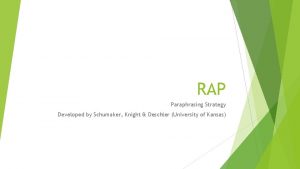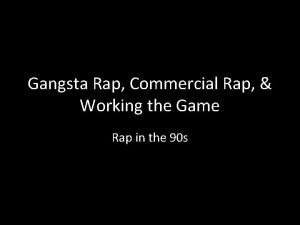Using the RAP Strategy for Reading Nonfiction A













- Slides: 13

Using the RAP Strategy for Reading Nonfiction: A Closer Look

Theatre classes often approach Greek theatre as if the art of that particular time was only a variation of modern practice. This attitude is understandable, given that many production elements common today, such as masks, costumes, music, and script, were used by the ancients, and a number of the texts are part of our cultural heritage. If we insist on seeing theatre history as an evolutionary progression, each period building on the last, gradually discarding outmoded methods and discovering the "new and improved, " then contemporary theatre must be the best. Modern theatre, with its profusion of technological applications, its costuming drawn in materials and concepts from around the world, with its constant novelty, must be theatrical pinnacle. All else must be inferior. Such an approach is misleading, however, and downright arrogant. Current historians acknowledge that the Greeks used many elements of production and style first, and that today's practices are the descendants of originals that were, in some ways, superior.

Theatre classes often approach Greek theatre as if the art of that particular time was only a variation of modern practice. This attitude is understandable, given that many production elements common today, such as masks, costumes, music, and script, were used by the ancients, and a number of the texts are part of our cultural heritage. If we insist on seeing theatre history as an evolutionary progression, each period building on the last, gradually discarding outmoded methods and discovering the "new and improved, " then contemporary theatre must be the best. Modern theatre, with its profusion of technological applications, its costuming drawn in materials and concepts from around the world, with its constant novelty, must be theatrical pinnacle. All else must be inferior. Such an approach is misleading, however, and downright arrogant. Current historians acknowledge that the Greeks used many elements of production and style first, and that today's practices are the descendants of originals that were, in some ways, superior.

Theatre classes often approach Greek theatre as if the art of that particular time was only a variation of modern practice. This attitude is understandable, given that many production elements common today, such as masks, costumes, music, and script, were used by the ancients, and a number of the texts are part of our cultural heritage. If we insist on seeing theatre history as an evolutionary progression, each period building onhthe t last, a w ow n k gradually discarding outmoded methods and discovering the "new s y a w l is a n u u o o y n t and improved, " then contemporary theatre tha pro must be the best. y e r n u a s to of technological t Bewith its cprofusion n e T Modern theatre, applications, its d A e H e W t n ”— e d theinamaterials u t costuming drawn and concepts from around the i t t a s i h t (i. e. , “ novelty, world, with its constant must be theatrical pinnacle. All ) ? e else must be inferior. Such an approach is misleading, however, attitud and downright arrogant. Current historians acknowledge that the Greeks used many elements of production and style first, and that today's practices are the descendants of originals that were, in some ways, superior.

f/then” soften cenaapproach rios are AGreek Theatre“Iclasses as if the art LWAYtheatre S imp ortawas nt. Bonly E Sa. Uvariation of that particular time RE to ideofnmodern tify the practice. This “then” that agiven attitude is understandable, many elements ccomthat panie s anproduction “if” in this common today, such music, and script, were typas e omasks, f situaticostumes, ons. used by the ancients, and a number of the texts are part of our cultural heritage. If we insist on seeing theatre history as an evolutionary progression, each period building on the last, gradually discarding outmoded methods and discovering the "new and improved, " then contemporary theatre must be the best. Modern theatre, with its profusion of technological applications, its costuming drawn in materials and concepts from around the world, with its constant novelty, must be theatrical pinnacle. All else must be inferior. Such an approach is misleading, however, and downright arrogant. Current historians acknowledge that the Greeks used many elements of production and style first, and that today's practices are the descendants of originals that were, in some ways, superior.

Theatre classes often approach Greek theatre as if the art of that particular time was only a variation of modern practice. This attitude is understandable, given that many production elements common today, such as masks, costumes, music, and script, were used by the ancients, and a number of the texts are part of our cultural heritage. If we insist on seeing theatre history as an evolutionary progression, each period building on the last, gradually discarding outmoded methods and discovering the "new and improved, " then contemporary theatre must be the best. Modern theatre, with its profusion of technological applications, its costuming drawn in materials and concepts from around the world, with its constant novelty, must be theatrical pinnacle. All else must be inferior. Such an approach is misleading, however, downright arrogant. Noand tice that Current historians acknowledge that the Greeks used many sentence the next two elements of production and style first, andsthat practices are today's s i m p e aborat ly ionsinosome are the descendants of originals lthat were, ways, superior. n scenario . the “if/th en”

Theatre classes often approach Greek theatre as if the art of that particular time was only a variation of modern practice. This attitude is understandable, given that many production elements common today, such as masks, ly costumes, music, and script, were e m e a number trand x used by the ancients, of the texts are part of our ls e a s n i ig on seeing theatre history as an r” If weit insist s e cultural heritage. v e e s w ’s u o h t a h i “ c evolutionary progression, each period building on the last, This rtant be rn in Sm gradually outmoded methods and discovering the "new o discarding u t p e m i iv and m improved, " then contemporary theatre must be the best. ass a. Modern with its profusion of technological applications, its stheatre, u c fo costuming drawn in materials and concepts from around the world, with its constant novelty, must be theatrical pinnacle. All else must be inferior. Such an approach is misleading, however, and downright arrogant. Current historians acknowledge that the Greeks used many elements of production and style first, and that today's practices are the descendants of originals that were, in some ways, superior.

Theatre classes often approach Greek theatre as if the art of that particular time was only a variation of modern practice. This attitude is understandable, given that many production elements common today, such as masks, costumes, music, and script, were used by the ancients, and a number of the texts are part of our cultural heritage. If we insist on seeing theatre history as an evolutionary progression, each period building on the last, gradually discarding outmoded methods and discovering the "new and improved, " then contemporary theatre must be the best. Modern theatre, with its profusion of technological applications, its costuming drawn in materials and concepts from around the world, with its constant novelty, must be theatrical pinnacle. All else must be inferior. Such an approach is misleading, however, and downright arrogant. Current historians acknowledge that the Greeks used many elements of production and style first, and that today's practices are the descendants of originals that were, in some ways, superior.

Theatre classes often approach Greek theatre as if the art of that particular time was only a variation of modern practice. This attitude is understandable, given that many production elements common today, such as masks, costumes, music, and script, were used by the ancients, and a number of the texts are part of our cultural heritage. If we insist on seeing theatre history as an evolutionary progression, each period building on the last, gradually discarding outmoded methods and discovering the "new and improved, " then contemporary theatre must be the best. Modern theatre, with its profusion of technological applications, its costuming drawn in materials and concepts from around the world, with its constant novelty, must be theatrical pinnacle. All else must be inferior. Such an approach is misleading, however, and downright arrogant. Current historians acknowledge that the Greeks used many elements of production and style first, and that today's practices are the descendants of originals that were, in some ways, superior.

“De” means “down, ” so “deduct” means to “lead down”—or to lead from the main idea DOWN to the details “In” means “in”—so “induct” means to “lead in”—or to lead INTO the main idea Analysis Point #1: Is the structure of ¶#1 deductive or inductive? . ” t c u d “ : s word d e z i c i l e ita of th h t o b f o ot o r e h t e l Circ “Duct” means “lead. ”

Analysis Point #1: Is the structure of ¶#1 deductive or inductive? Because Nola Smith’s last sentence of ¶#1 best illustrates her most important point, and because she begins with details that lead to that main point, her structure in this paragraph is inductive.

Analysis Point #2: The last sentence of ¶#1 does represent the main idea of the important details.

Analysis Point #3: Paraphrase that last sentence (the main idea sentence). Remember that a paraphrase puts an author’s idea into your own words.
 Text features rap
Text features rap Rap rap artinya
Rap rap artinya While reading activities
While reading activities Rap strategy example
Rap strategy example What is absolute language in reading
What is absolute language in reading Nonfiction reading test black friday
Nonfiction reading test black friday Kontinuitetshantering
Kontinuitetshantering Typiska novell drag
Typiska novell drag Tack för att ni lyssnade bild
Tack för att ni lyssnade bild Ekologiskt fotavtryck
Ekologiskt fotavtryck Varför kallas perioden 1918-1939 för mellankrigstiden?
Varför kallas perioden 1918-1939 för mellankrigstiden? En lathund för arbete med kontinuitetshantering
En lathund för arbete med kontinuitetshantering Särskild löneskatt för pensionskostnader
Särskild löneskatt för pensionskostnader Personlig tidbok för yrkesförare
Personlig tidbok för yrkesförare

























